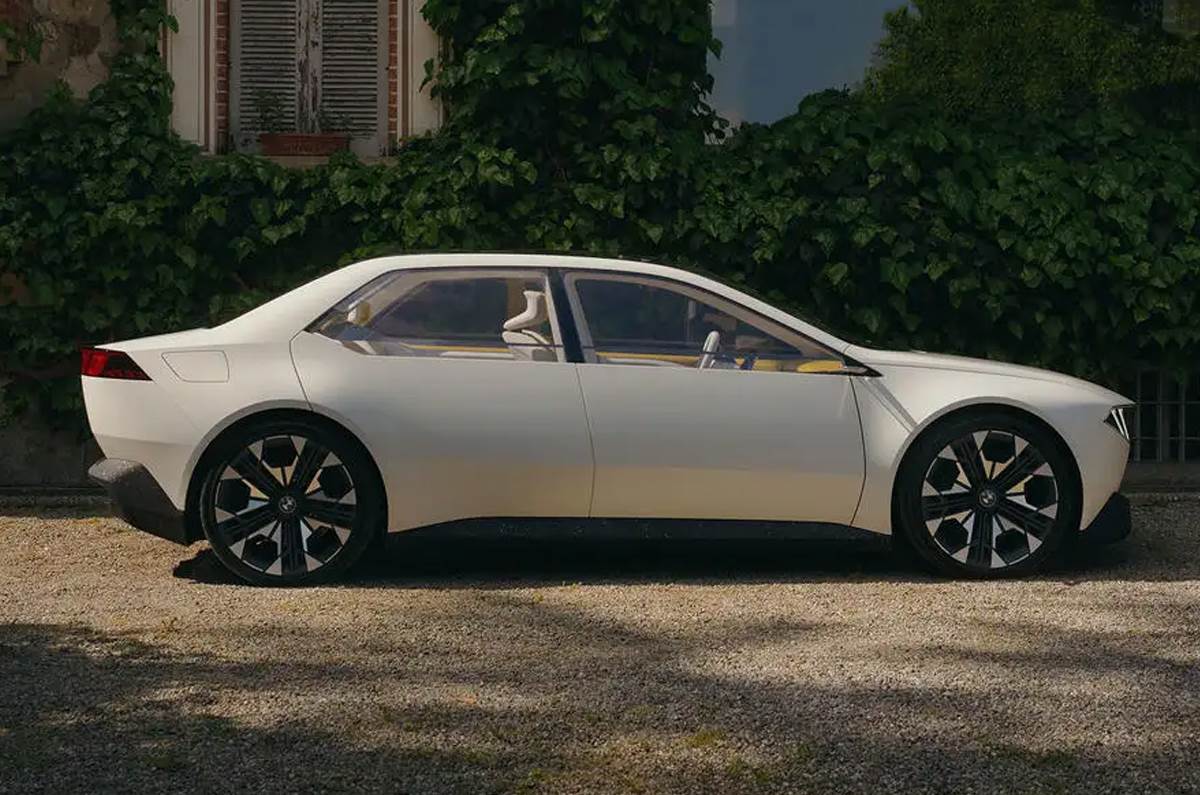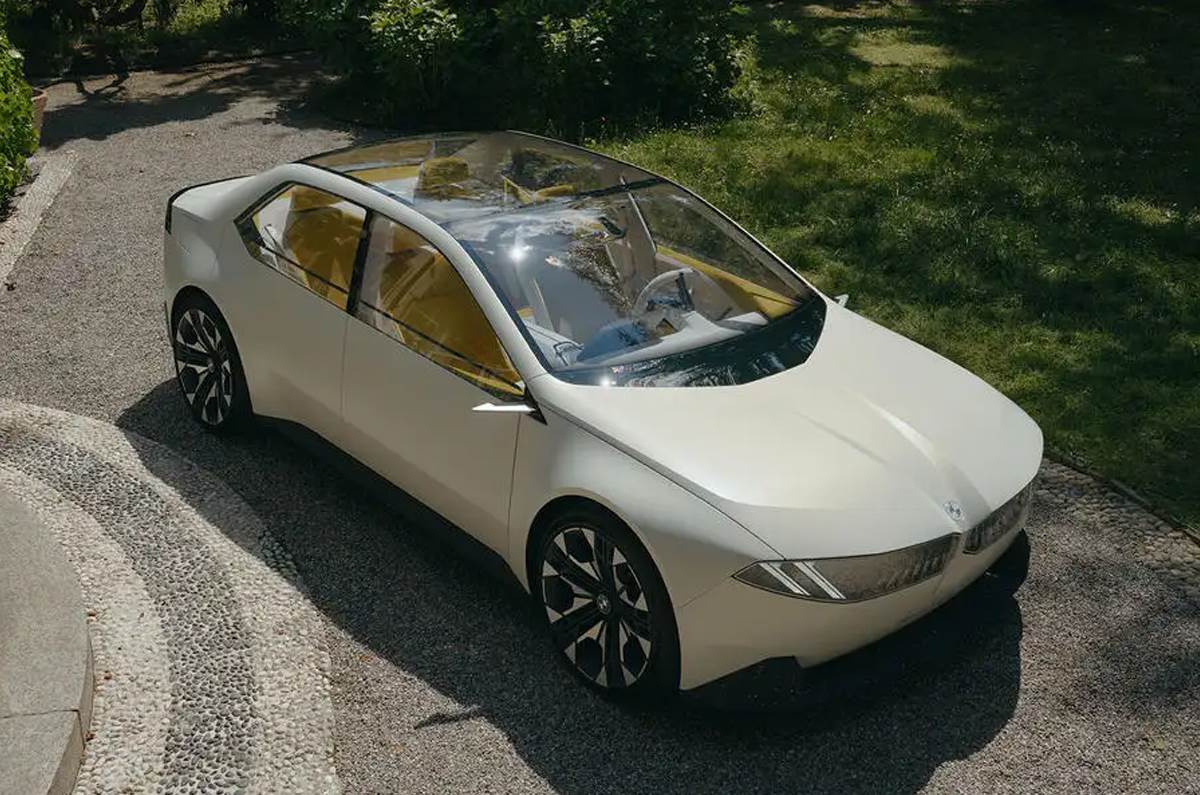Showcased at the ongoing Munich Motor Show, this previews a future 3-Series sized electric sedan.
BMW has showcased the Vision Neue Klasse concept at the ongoing Munich Motor Show which gives the best look yet at BMW’s all-electric future. It previews a dramatic change in exterior and interior design direction alongside the introduction of highly advanced drivetrain technology.
BMW’s ambition with Neue Klasse
By the end of 2023, BMW will have an electric car on sale in each of its core market segments, and it aims for more than a quarter of its global sales to be electric by 2025, rising to a third just a year later. Now well on the way to achieving those goals with its current fleet of electric sedans and SUVs, BMW is shifting its focus to the launch of a radical new family of EVs.
It has dubbed this ‘Neue Klasse’ as a reference to the family of brand-reshaping premium sedans and coupés that it launched in the 1960s.

BMW will launch six Neue Klasse EVs in the space of 24 months, although not all of them will be based on the same platform because of the differing requirements of the various segments BMW seeks to cover. CEO Oliver Zipse pledged: “From SUV to sedan, we will have something for every customer.”
The first is set to be a striking 3 Series-sized sedan, and while BMW bosses said this new Vision Neue Klasse concept doesn’t directly preview a production car, it’s understood that it gives strong clues about what to expect from this pioneering EV.
Beneath the skin, the new sedan – and its closely related range-mates – will be almost completely unrelated to BMW’s current crop of EVs, and this technological revolution will be signalled by a totally new design treatment that does away with many established hallmarks and reinterprets others for the new era.
BMW Vision Neue Klasse exterior design
The Vision Neue Klasse is clearly an evolution of the outlandish i Vision Dee concept that BMW showed at CES in Las Vegas earlier this year, drawing on that car’s sharp-angled silhouette but with wide-reaching refinements that paint it more obviously as a close preview of a production car.

BMW has labelled it “clear, elegant, timeless”, highlighting features that will become hallmarks of the Neue Klasse line-up, including a broader, horizontal interpretation of the firm’s kidney grilles, expansive side windows, slimline LED light designs and a “monolithic” silhouette, which is, according to design boss Domagoj Dukec is, “much cleaner in its surfacing and details” than those of recent BMW cars. Not only does this promote a fresh, futuristic treatment, it also means Neue Klasse cars can be made with simpler tooling and fewer components.
The front end is described as a “single interaction area”, with the headlights programmed to display an animation when users approach the car. “Light has helped us strengthen our identity in recent years,” explained Dukec, adding that BMW wants “to replace chrome with light”. Meanwhile, the ‘grille’ panels are designed to host the many cameras and sensors needed for high-level driver assistance functions, although hidden behind the seemingly opaque bodywork for a cleaner look.

The ‘grille’ could also, it has been suggested, display notifications about the car’s charging status or even direction indicators. Similarly, the light clusters could show different colours and designs depending on which driving mode is selected.
Notably, while SUVs account for a huge proportion of BMW’s global sales, the Vision Neue Klasse and i Vision Dee concepts have taken the form of saloons, because the firm believes “there is still a future for flat, low cars – especially the [sedan]”, according to Dukec.
BMW Vision Neue Klasse interior design
Neue Klasse EVs will be marked out from current cars by their minimalist cockpits, which feature only the bare minimum of physical controls, even dropping the iDrive rotary control knob that has been a hallmark of the brand’s interiors since the E65-generation BMW 7 Series arrived in 2001.
Instead, users interact with the new system using a slick central touchscreen, BMW’s voice-activated Intelligent Personal Assistant and a new Panoramic Vision head-up display, which extends across the entire windscreen to provide information at “the ideal height” for the driver and front passenger.

This is operated primarily using a switch on the right-hand spoke of the steering wheel, but the driver can transfer content from the touchscreen to the holographic projection using a swiping gesture. Other clues to Neue Klasse interiors come in the form of the concept’s bright yellow corduroy upholstery, chunky, squared-off steering wheel and ‘floating’ centre console, which holds a wireless phone charger. Also, BMW highlights that just one bracket supports each of the front seats, leaving more room for rear passengers’ feet.
BMW Vision Neue Klasse technical details
Technical details of BMW’s next-generation EV platform remain to be revealed, but R&D boss Frank Weber said it will bring “30 percent more range, 30 percent faster charging, and 25 percent more efficiency” compared with current cars.
BMW’s new Gen6 lithium-ion batteries – with cylindrical rather than prismatic cells and slimmer than current units – will be 20 percent more energy-dense, able to charge at up to 270kW (to add 300km in just 10 minutes) and ultimately offer up to 1000km of range.

Changes to the design and production processes of these next-generation batteries are estimated to cut costs by as much as 50 percent, which could have significant implications for the final prices of BMW’s EVs – although the firm has given no indication of what the Neue Klasse cars will cost.
The EVs will initially be built at BMW’s new factory in Debrecen, Hungary, in a process that is said to be entirely free from fossil fuels, be much more dependent on the use of secondary materials and have a lower CO2 output.
Also See:
New Mini Cooper EV India launch in Q1 2024
Refreshed Tesla Model 3 breaks cover

